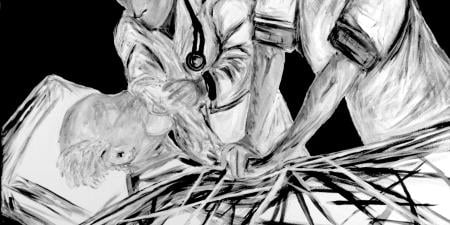Abstract
We discuss physician aid in dying, euthanasia, and other dimensions of palliative care decision making and define relevant terms raised by this case of a dying patient with amyotrophic lateral sclerosis in Washington State who is unable to self-administer a lethal prescription. We then present a concrete framework that clinicians can directly apply when faced with difficult cases such as this one. We outline how exploring motivations, obtaining informed consent, defining goals, and examining alternatives can help guide physicians like the one in this case. We conclude by summarizing one way in which physicians might balance these issues while still remaining within the constraints of the law.
Case
Dr. S is a palliative care physician in Washington State. He follows a panel of patients longitudinally through their various disease courses. Today in clinic, Dr. S meets with Donald, a patient he’s taken care of for a year and has been seeing about once per month. Donald was diagnosed with amyotrophic lateral sclerosis (ALS) last year at the age of 49. Prior to diagnosis, Donald’s livelihood was completely dependent on optimal physical fitness and dexterity; as a marathon runner and professional violinist, ALS was profoundly devastating. Over the past year, his disease has been progressing rapidly. Initially presenting with right foot weakness, he now gets around in a wheelchair and health aides help him bathe, use the bathroom, dress, and eat. He has developed mild bilateral upper extremity contractures and is unable to use his hands to carry out even simple tasks. So far, his respiratory function, though declining, has remained intact, but his swallowing function is beginning to deteriorate. He was recently started on a dysphagia diet of pureed food and thickened liquids.
During his appointment, Donald tells Dr. S that, after giving it much thought, he has decided that he wishes to end his life. He explains that his illness has robbed him of everything that has defined him and created meaning in his life—he can no longer run or play his violin, and he is not comfortable being dependent on others for all his basic needs. He knows the disease will inevitably progress to the point at which he will become ventilator dependent, and he is certain that living this way would never be acceptable to him. “Right now, I can eat. I can talk. I can breathe. I want to die before I lose anything else of importance to me.” He asks Dr. S to help him end his life, acknowledging that he is no longer physically able to do so.
For Dr. S, having cared for countless patients suffering from terminal illnesses and practicing in a state that recently passed a death with dignity law, this request is not a new one. Dr. S agrees, in certain circumstances, that physician assistance in dying is appropriate. However, in Donald’s case, due to his physical inability to actually take any medications prescribed to hasten his death, Dr. S realizes that his role in Donald’s dying process would, at this point, have to be more than “assistance,” which he finds troubling. Legally, if Donald passed through the rigorous psychological testing approved by the state, then he would be entitled to a prescription of the needed medication, but Donald’s physical inability to voluntarily administer it himself means that he can’t actually exercise the right this law grants him. Dr. S regrets that Donald cannot take advantage of this law, which was passed specifically to help terminally ill patients like him in nearly every way except in his incapacity to self-administer a lethal prescription. Dr. S worries that if he does not offer medical assistance to Donald, Donald could feel abandoned, desperate, and helpless and become pressed into a situation in which he pursues a path to death that is isolated, protracted, or violent. Dr. S wonders how to respond to Donald’s request for help.
Commentary
Donald’s case presents a challenging ethical dilemma that asks us to reflect on the ways in which a physician can act as healer at the end of life. Also relevant are legal issues related to physician aid in dying (PAD), which are important to consider separately from the ethical issues. In this essay, we focus specifically on an ethical framework for physicians faced with difficult end-of-life situations such as Donald’s. We offer some ways in which Dr. S can honor Donald’s wishes while still remaining on solid ethical footing; we will also discuss the legal implications of Donald’s request in the context of acting ethically. Here, we assume that PAD is morally acceptable to Dr. S but that he is troubled by this extension of PAD, which would require him to assume a more active role in Donald’s death.
PAD vs Euthanasia
Donald’s request highlights the defining line between PAD and euthanasia. Because PAD and euthanasia assign agency very differently to patients and physicians, and because euthanasia would be categorically prohibited under all PAD laws in the US, it is critical to differentiate between the two in this case.
Legally, PAD and euthanasia are differentiated by the degree of physician involvement. In PAD, physicians prescribe lethal drugs that their patients self-administer, whereas in voluntary active euthanasia, physicians themselves administer lethal drugs upon request by the patient.1,2 In the United States, debates over PAD and euthanasia were highlighted in People v Kevorkian (2001), a case in which the physician Jack Kevorkian appealed his conviction for second-degree murder in the death of a patient with ALS. In this case, the Michigan Court of Appeals ruled that physician-assisted suicide was tantamount to murder.3 Because the Court indicated that recognizing “a right to be free from intolerable and irremediable suffering” was better left to the state legislatures,3 it is notable that, since the decision, multiple US states have chosen to enact legislation legalizing PAD.4,5 Death with dignity (DWD) legislation in Washington and in other states appears to explicitly exclude patients such as Donald since the drug must be self-ingested4 and the alternative, euthanasia, is illegal in all US states,6 although it is legal in Belgium and the Netherlands provided patients give their explicit consent.7
Due to patients’ inability to self-ingest lethal drugs, ALS is a disease that lies at the center of ethical debates surrounding PAD. In Washington State, eligibility criteria based on a “reasonable medical judgment”4 include a capacity to make decisions, a prognosis of 6 months or less, and an ability to self-ingest the lethal drug. In contrast, the Oregon law is less clear in its requirement for patients to self-administer.5 People might assume that the disease trajectory of ALS bars them from utilizing death with dignity laws, but some Washington State clinicians note that patients occasionally “needed to compress a syringe to ‘self-administer’ the medication,”8 which is technically legal because it represents “a qualified patient’s act of ingesting medication to end his or her life.”4
Steps to Honoring PAD
When patients ask physicians for assistance in ending their lives and state laws include PAD as an option, it is helpful to consider the following steps to honor these requests. While there are clearly legal issues to consider, here we focus on the ethical issues inherent in the case.
Explore motivations. First, before offering a response, the physician should explore the patient’s reasons for the request. The physician should also identify, treat, or refer for any psychiatric conditions that might be relevant. In this case, Donald’s motivations are relatively clear. Loss of ability to engage in activities that make life meaningful is a common reason for terminally ill patients to pursue PAD, as is desire for control over the way their death arrives.9 Merely having the drug available might help strengthen patients’ feelings of self-determination. It is also important that physicians be mindful of their own personal responses to requests like Donald’s, as PAD is an issue that can evoke strong reactions from many physicians.10 Because exploring motivations is required for physicians to do right by their patients, it is at this point that the framework of principlism becomes relevant.11 Applying principlism, the physician identifies and weighs harms and benefits, seeking to maximize beneficence, nonmaleficence, respect for autonomy, and justice as relevant to the case.
Physicians should invest time and energy in conversations devoted to exploring patients’ motivations for their goals at the end of life in order to consider what is in their best interests and to maximize beneficence. The challenge is that it is often unclear what constitutes “beneficial.” In pursuing beneficence, Dr. S should consider Donald’s positive right to a “good death” as he defines it. Importantly, this right requires Dr. S to explore what Donald considers a “good life” and how the quality of his life has been affected by ALS. Dr. S must be mindful of the fact that the meaning—ie, the subjectively perceived existential value—of one’s own life is not static but rather changes over one’s lifetime, sometimes very quickly as death approaches. Additionally, he needs to consider Donald’s negative right to be free from existential suffering—from loss of what makes him a whole person, of the ability to do the things that sustain meaning in his life, and of his independence.
While physicians are obligated to explore what a good life and good death mean for their patients, it is crucial that the patients define these terms for themselves, lest physicians not only fail to maximize beneficence but also jeopardize respect for autonomy.
Obtain informed consent. Once Donald’s motivations have been thoroughly explored and determined to be genuinely his own, Dr. S should next secure informed consent from Donald. This is an ethical requirement for respecting Donald’s autonomy12 as well as a formal legal requirement for accessing the death with dignity law.4 Donald has already articulated an understanding of his situation and expressed a coherent choice through sound reasoning, but no discussion of consent is complete without eliciting patient understanding of the alternatives. Dr. S should discuss with Donald what living with his disease could look like with palliative care (loss of function and symptom management) and without palliative care (loss of function and progressively worsening symptoms). Donald should be made aware of the wide spectrum of palliative care options (discussed below in more detail) and that he does not have to accept additional life-sustaining treatments that are inconsistent with his goals and values.
Additionally, although Donald seems to clearly have capacity in this case, physicians in general should consider the decision-making capacity of their patients in such situations. Surrogates should be aware of and participate in these discussions so that they can continue to advocate for the patient when the patient loses capacity.
Finally, negative autonomy, or “freedom from,” is also relevant. Donald as well as future patients should be free from potential abuse from active physician involvement without patient consent, and Dr. S should likewise be free from being forced to prescribe against his own ethical convictions.13
Define goals. After learning what brings meaning to the patient’s life, the physician should discuss the prognosis and goals of care with the patient to avoid treatments that could do the patient more harm than good. Dr. S needs to specify what nonmaleficence or to “do no harm” means, which includes accounting for both potential and actual harms to Donald. However, specifying what constitutes nonmaleficence is not always easy, and physicians often have strong opinions on what is appropriate. It is important to recognize that, for many physicians, PAD entails an actual harm ipso facto to the patient. On this view, engaging in PAD would violate the physician’s oath, and it would therefore be categorically impossible to respect the principle of nonmaleficence through PAD.14-17 Others may believe that by not honoring Donald’s request and allowing his natural disease course to continue, Dr. S would be bringing about significant actual harm to the patient-physician relationship or a potentially painful, isolated, or otherwise problematic death, including suicide.
Significant harm can come to patients when clinicians deny patients’ agency, choice, or autonomy. Therefore, Dr. S needs to find out what Donald hopes to get from health care. It is wrong to assume that death per se is Donald’s only goal. In fact, implicit in the case description is that Donald wants freedom from suffering further decline in his ability to engage in meaningful pursuits. Other possible goals could be maintaining self-determination, having a peaceful death, preserving dignity, or avoiding an isolated state in which he is unable to interact with loved ones in a meaningful way. When considering nonmaleficence, all physicians need to weigh the inherent harms they attribute to PAD against the potential harms of refusing to prescribe lethal drugs. This particular balance will vary for each physician, patient, and situation.
Examine alternatives. Finally, the physician should discuss alternative management options. Apart from PAD, Donald might not be aware of the spectrum of end-of-life interventions, any one of which might be at least as well aligned with his goals and wishes as PAD. In addition to aggressive palliative care support, these interventions include voluntarily stopping eating and drinking, withdrawal of respiratory support and life-sustaining treatments, pain medications that are known to hasten death, and palliative sedation. Although in this case Donald has actively sought out PAD on his own initiative, in general physicians should be careful never to present PAD as the only option. Furthermore, Dr. S should ensure that Donald’s palliative care needs are being adequately addressed and that he is aware of hospice as an option, since inadequate symptom management could be a motivation for Donald to pursue PAD.18
In addition to exploring Donald’s motivations related to his personal experience, Dr. S should explore other potential motivations for Donald’s seeking PAD. In particular, Dr. S should ensure that Donald is not seeking lethal drugs due to lack of financial resources to pursue other palliative care options. Despite the high cost of PAD drugs (approximately $3 000),19 they are still significantly less expensive than many life-sustaining treatments, especially when a complex disease approaches its terminus. It would be an injustice to offer PAD in the setting of inadequate palliative care services, a concern that disproportionally harms patients of lower socioeconomic status. The case of Barbara Wagner in Oregon is perhaps the best example of this injustice: her insurance provider refused to pay for erlotinib, an expensive chemotherapy treatment, but did offer to reimburse PAD drugs; her case is unfortunately not isolated.20 PAD must not become a preferentially attractive option for the poor; instead, the physician should make every attempt to connect the patient with other resources.
It is also important for physicians to be mindful of how race can affect choice or discussion of PAD. African-American patients are less likely than white patients to enroll in palliative care,21 possibly due to medicine’s history of marginalizing this population and existing structural injustices. There has been concern that PAD could negatively affect vulnerable populations.18 Discussions of PAD might pose particular challenges for minorities, whose attitudes surrounding death and dying might reflect mistrust in health care professionals in part due to personal and historical experiences.21
Reflections
This concrete framework would help Dr. S understand Donald’s request and also allow Donald to consider other options that might be better aligned with his motivations and goals. If Donald still wants Dr. S to help him end his life, Dr. S could consider one approach that has been used in Washington State: family members preparing the drug and assisting with its placement in the patient’s mouth or feeding tube. If this approach were used with Donald, Donald would then subsequently self-administer by moving his head or by pushing the syringe with the lethal drug into his mouth or feeding tube.22 If Dr. S feels this option would be appropriate for him and his patient, it would allow Donald to exercise his autonomy while enabling Dr. S to minimize nonmaleficence by maintaining the patient-physician relationship. Ethically it could be permissible and, in Washington State, compressing a syringe to self-administer has been found to be legally acceptable, as discussed above. However, legally there is controversy surrounding this option in some US states,22 given that it could be seen to constitute euthanasia. Currently, this option resides in a legal and ethical gray zone.
PAD presents significant ethical challenges, especially when patients are unable to self-administer the drugs. Physicians should plan for in-depth conversations exploring motivations, determining capacity, defining goals, and elaborating alternatives. Throughout this process, it is vital that physicians remain aware of their own personal reactions to the patient’s request and be mindful of strong views on this issue. Physicians should also seek the support of their colleagues in palliative care for both symptom management and goals-of-care conversations.
References
- Fins JJ, Bacchetta MD. Framing the physician–assisted suicide and voluntary active euthanasia debate: the role of deontology, consequentialism, and clinical pragmatism. J Am Geriatr Soc. 1995;43(5):563-568.
- Emanuel EJ. Euthanasia: historical, ethical, and empiric perspectives. Arch Intern Med. 1994;154(17):1890-1901.
-
People v Kevorkian, 639 NW2d 291 (Mich Ct App 2001).
-
Wash Rev Code ch 70.245 (2008).
-
Or Rev Stat ch 127 (1997).
- Emanuel EJ, Daniels ER, Fairclough DL, Clarridge BR. The practice of euthanasia and physician-assisted suicide in the United States: adherence to proposed safeguards and effects on physicians. JAMA. 1998;280(6):507-513.
- Cassel CK, Cassel CK. Morals and moralism in the debate over euthanasia and assisted suicide. New Engl J Med. 1990;323(11):750-752.
- Wang LH, Elliott MA, Jung Henson L, et al. Death with dignity in Washington patients with amyotrophic lateral sclerosis. Neurology. 2016;87(20):2117-2122.
-
Oregon Department of Health. Oregon Death with Dignity Act: 2015 data summary. https://www.oregon.gov/oha/ph/ProviderPartnerResources/EvaluationResearch/DeathwithDignityAct/Documents/year18.pdf. Published February 4, 2016. Accessed February 21, 2018.
- Back AL, Starks H, Hsu C, Gordon JR, Bharucha A, Pearlman RA. Clinician-patient interactions about requests for physician-assisted suicide: a patient and family view. Arch Intern Med. 2002;162(11):1257-1265.
-
Beauchamp TL, Childress JF. Principles of Biomedical Ethics. 3rd ed. Oxford, UK: Oxford University Press; 1989.
-
Faden RR, Beauchamp TL. A History and Theory of Informed Consent. New York, NY: Oxford University Press; 1986.
- Genuis SJ. Dismembering the ethical physician. Postgrad Med J. 2006;82(966):233-238.
- Cohen JS, Fihn SD, Boyko EJ, Jonsen AR, Wood RW. Attitudes toward assisted suicide and euthanasia among physicians in Washington State. N Engl J Med. 1994;331(2):89-94.
- Ganzini L, Nelson HD, Lee MA, Kraemer DF, Schmidt TA, Delorit MA. Oregon physicians’ attitudes about and experiences with end-of-life care since passage of the Oregon Death with Dignity Act. JAMA. 2001;285(18):2363-2369.
- Dobscha SK, Heintz RT, Press N, Ganzini L. Oregon physicians’ responses to requests for assisted suicide: a qualitative study. J Pall Med. 2004;7(3):451-461.
- Meier DE, Emmons CA, Wallenstein S, Quill T, Morrison RS, Cassel CK. A national survey of physician-assisted suicide and euthanasia in the United States. N Engl J Med. 1998;338(17):1193-1201.
- Petrillo LA, Dzeng E, Smith AK. California’s End of Life Option Act: opportunities and challenges ahead. J Gen Intern Med. 2016;31(8):828-829.
-
Dembosky A. Drug company jacks up cost of aid-in-dying medication. NPR. March 23, 2016. https://www.npr.org/sections/health-shots/2016/03/23/471595323/drug-company-jacks-up-cost-of-aid-in-dying-medication. Accessed June 11, 2018.
-
James SD. Death drugs cause uproar in Oregon. ABC News. August 6, 2008. http://abcnews.go.com/Health/story?id=5517492&page=1. Accessed March 7, 2018.
- Johnson KS. Racial and ethnic disparities in palliative care. J Palliat Med. 2013;16(11):1329-1334.
-
Stump E. Assisted suicide legal in Washington. Neurol Now. 2009;5(1):9-10.



